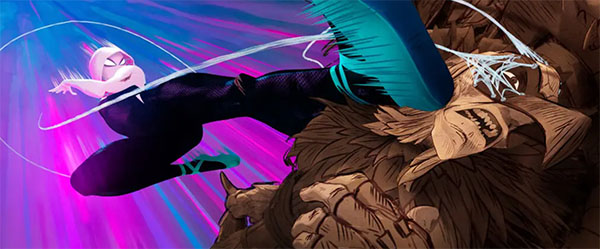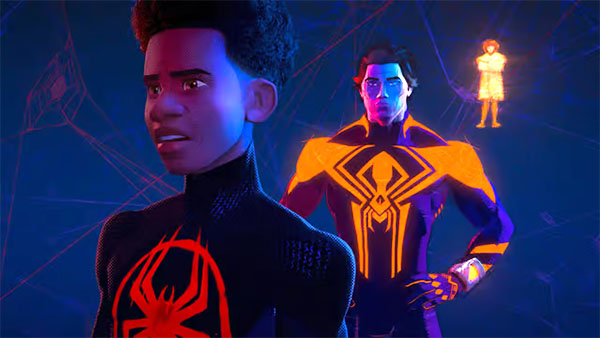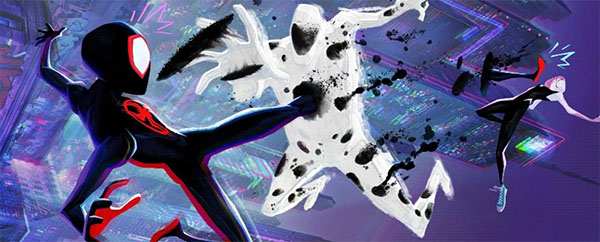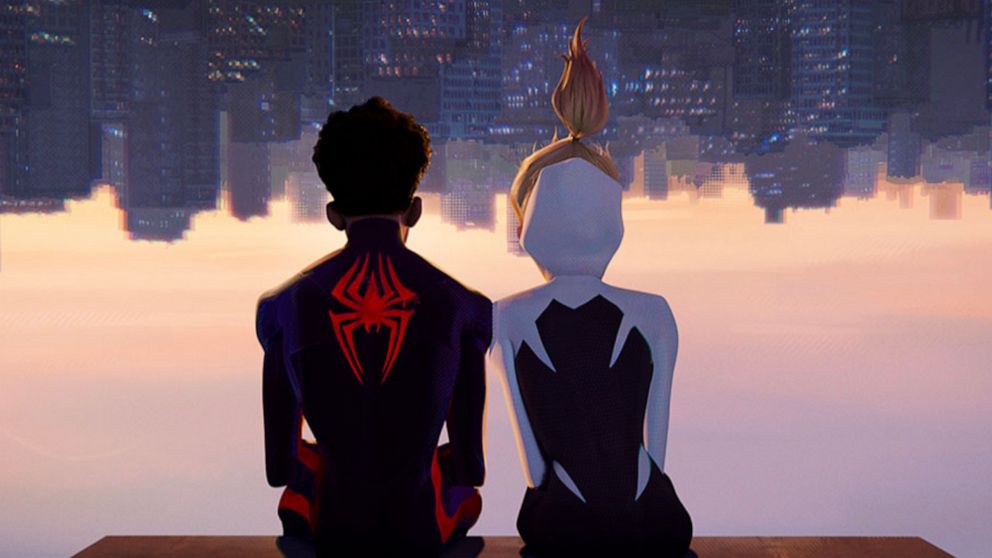Spider-Man: Across the Spider-Verse (2023, Dir. Joaquim Dos Santos, Kemp Powers, Justin K. Thompson):
When Spider-Man: Into the Spider-Verse hit theaters in 2018, there had never been anything quite like it. Oh sure, there had been Spider-Man movies before, and animated superhero movies (and even animated Spider-Man shows), but this was a different animal (or arachnid, should we say): a showstopper that married visual wow with assured storytelling. Taking full advantage of the medium for eye-popping effects, yet infused with a soulful vibe (much like hero Miles Morales going all atingle with Spidey senses), Into the Spider-Verse was the rare blockbuster that didn’t sacrifice personality for thrills.
That same sense of ingratiating wonder comes out to play in Spider-Man: Across the Spider-Verse, but like Back to the Future II, the franchise sequel it resembles most, Across stretches its conceit in exponentially more intricate and frenetic directions (like an endless web, one might say). When we last left Miles (voiced by Shameik Moore), he had sealed up a potentially disastrous breach between parallel universes, saving the day but cutting himself off from his new buddies Gwen Stacy (Hailee Steinfeld) and Peter Parker (Jake Johnson), the Spider-heroes of their own individual universes. Across‘s prologue provides an overdue, angst-ridden backstory for Gwen, whose secret identity finds her at odds with her police captain father (Shea Whigham), who’s intent on apprehending “Spider-Woman” for a murder she didn’t commit. Just as this family drama reaches a crisis point, all figurative and visual hell breaks loose with the arrival of the villainous Vulture from another universe. Gwen’s throwdown with Vulture is staged in an art museum, the action moving at eye-blink tempo (with plenty of art jokes thrown in, natch). “You call this art?” Vulture sneers at the displays. “We’re talking about it, aren’t we?” Gwen retorts. Oh yes, art—the visual palettes alone are dazzling. Gwen’s universe is represented by pastel swathes of purple, orange and blue, while the monochromatic Vulture has the hard, precise lines of a da Vinci illustration (we’re told so, just in case we didn’t get the reference), even as he occasionally de-rezzes into rainbow-colored fractals.

Vulture’s incursion isn’t an isolated incident; breaches between universes are increasing in number, and a passel of Spider-heroes from all over the multi-verse, led by the brooding Miguel O’Hara (Oscar Isaac) have formed a “Spider Society” to maintain order. This type of universe-hopping mayhem has formed the basis of Marvel TV series like Loki as well as the latest Dr. Strange and Antman movies. But Across the Spider-Verse outdoes them all in spectacle and chutzpah, as we meet hundreds of Spider-persons (not to mention Spider-cats, dinosaurs and cars), with even stop-motion Lego and live-action versions of Spider-Man getting a shoutout. Miles is raring to join the fun, but with newfound knowledge comes unexpected revelations that assault his own identity as a superhero.
Of all the comic book movies, Across the Spider-Verse may be the comic-bookiest. Every frame seems to have sprung full-born from the panels of a graphic novel, sound effects from “thwip” to “crash” are spelled out, and even editor footnotes pop up on occasion. While other films that rip their look straight from the printed source like Zach Snyder’s Watchmen often feel posed and ponderous, Across the Spider-Verse honors the “motion” in motion picture, as Miles and his rubbery comrades bound off walls and skyscrapers, through the skies, and under and through collapsing buildings. The primal appeal of Spider-Man—his very earthbound domestic troubles counterbalanced by the dizzying freedom of slinging himself into the skies at a moment’s notice—is never more apparent and better realized than it is here. Indeed, the film is a meta-commentary on comic book storytelling in general, as well as the tenet of power and responsibility that informs the Spider-Man legend. Like any rabid fanboy, Miguel is committed to preserving the “canon” across all universes, which means that every Spider-hero must undergo the traumatic loss of a loved one—even if such a fate must be engineered by the Spider Society.

Everyone keeps telling me how my story is supposed to go. Nah. I’m-a do my own thing.
Miles Morales
Miles, being the freewheeling maverick he is, rebels against that notion, but first he has to contend with The Spot (Jason Schwartzman), a chatty would-be archnemesis intent on revenge against Miles’s family after being accidentally transformed into a featureless mutant with trans-dimensional portals built into his body. Spot’s antics threaten to bust the multiverse wide open, and his face-offs with Miles lead to amusing physics-defying feats (think of the Portal video game given a flesh and blood avatar). The amount of motormouthed banter is also amped up, as both Miles and Spot natter at each other at a hundred miles per hour; it’s fun and gets exhausting fast.

In comparison to its predecessor, Across the Spider-verse leans a bit too heavily on awe rather than charm, and its ponderings on superhero fate and destiny aren’t as relatable as the first film’s inclusive message of being the best version of yourself you can be. Still, give credit to the producer/writer team of Phil Lord and Christopher Miller for maintaining a sense of sly humor and humanity even as they get as rambunctious as eight-year-olds smashing action figures together. The characters (and the universes they habit) get their own distinctive quirks, whether it’s Johnson’s Peter Parker fawning over his infant Spider-daughter, an anarchic punk version of Spider-Man (Daniel Kaluuya) who looks like he belongs on a Sex Pistols poster, a badass (and very pregnant) Spider-Woman on a motorcycle (Issa Rae) or an Indian variant (Karan Soni) with the toothsome confidence of a Bollywood star. Amid all the spaced-out action and multiverse-shaking events, the most dramatic moments are striking in their modesty: the push and pull between Miles and his well-meaning but flummoxed parents (Brian Tyree Henry and Luna Lauren Velez), Gwen’s tortured confrontations with her dad, Miles and Gwen sharing a moment of camaraderie on New York’s rooftops as the city skyline shimmers beneath them like reflections in a pool.

Of course, this being a comic-book movie, things must get out of hand, and a final pursuit of Miles by multitudes of Spider-heroes (which throws in the classic “Spider-Men pointing at each other” meme for good measure) goes messily over the top. Faring better is a denouement that promises further multiverse complications, existential quandaries and a rebellion that rivals Captain America: Civil War in the next installment. But forget universe-building (and imploding); Across the Spider-Verse, like the Beatles song it steals its title from, is at its stirring best when worldly considerations fall away and bliss takes over, as its heroes trip the skyline fantastic, riding the boundaries between freedom and responsibility. ■

